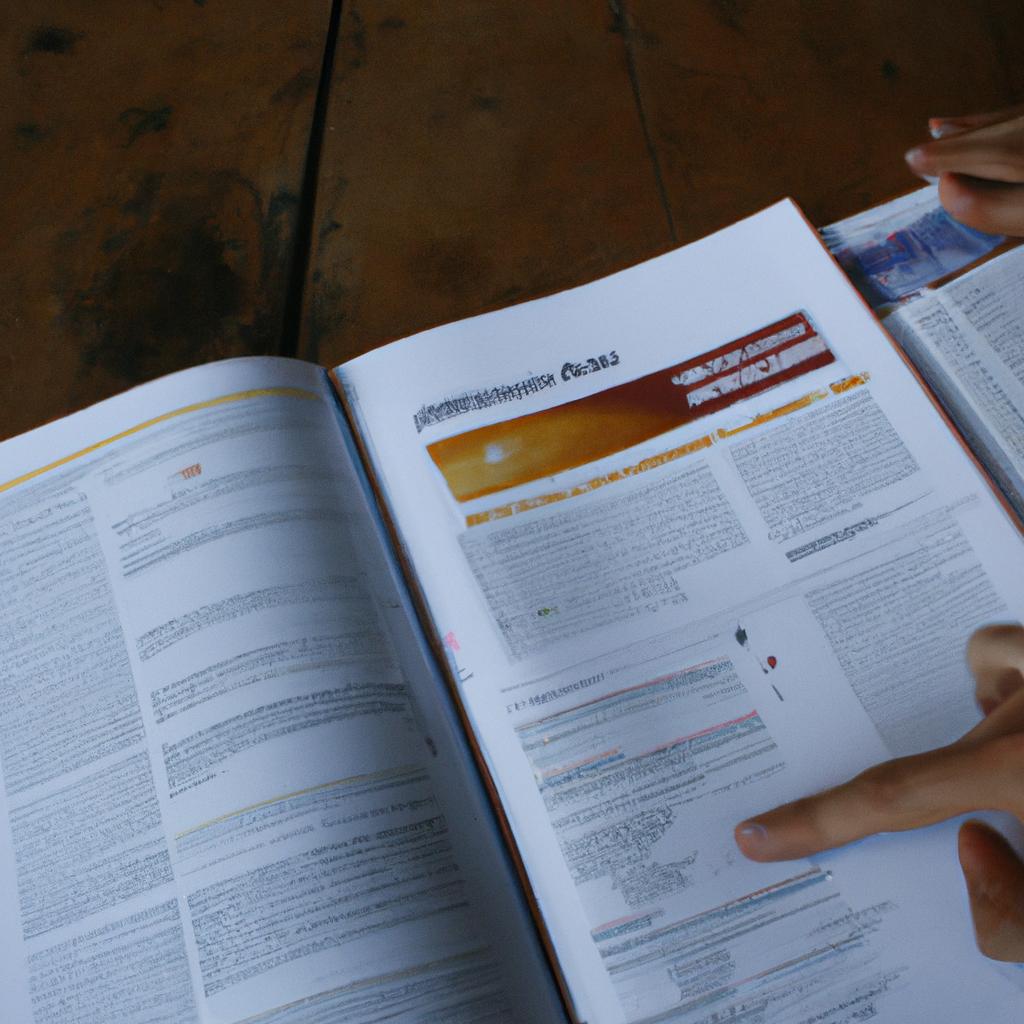Payday loans have become a prevalent form of short-term borrowing for individuals facing financial constraints, particularly in low-income communities. These high-interest loans are often marketed as quick and easily accessible solutions to immediate financial needs. However, the impact of payday loans on these vulnerable communities has raised concerns among scholars and policymakers alike. This article aims to provide an analysis of the social sciences perspective on the effects of payday loans on low-income communities, exploring both the individual and societal consequences.
To illustrate the potential ramifications of payday loans, let us consider a hypothetical case study involving Maria, a single mother living in a low-income community. Facing an unexpected car repair bill that she cannot afford to pay upfront, Maria turns to a local payday lender for assistance. Enticed by promises of instant cash with minimal requirements, she takes out a loan without fully comprehending its terms and conditions. As time passes, Maria finds herself trapped in a cycle of debt due to exorbitant interest rates and fees imposed by the lender. Unable to repay the loan on time, her financial situation deteriorates further, leading to increased stress and anxiety for both herself and her family.
Economic Vulnerability in Low-Income Communities
Low-income communities are particularly susceptible to economic vulnerability due to various factors such as limited access to resources and financial services, inadequate employment opportunities, and a lack of financial literacy. A case study conducted in 2019 by the Economic Policy Institute illustrates this vulnerability through the example of Eastside, a predominantly low-income neighborhood located in Cityville.
In Eastside, residents face numerous challenges that contribute to their economic vulnerability. Firstly, many individuals in this community struggle with unemployment or underemployment, leading to unstable income streams. This precariousness often hinders their ability to meet basic needs and save for emergencies or future expenses.
Moreover, limited access to affordable housing options further exacerbates the economic vulnerability within low-income communities like Eastside. High rental costs force residents to allocate a significant portion of their income towards housing expenses, leaving little room for savings or investment in other areas. As a consequence, they become more vulnerable to unexpected financial shocks such as medical emergencies or car repairs.
- Constant anxiety over meeting basic needs
- Persistent stress caused by financial insecurity
- Limited opportunities for upward mobility
- Feeling trapped in a cycle of poverty
Furthermore, it is essential to highlight the interplay between these factors using a table format:
| Factors contributing | Impact on | Consequences |
|---|---|---|
| Unemployment/underemployment | Financial instability | Inability to cover expenses |
| Lack of affordable housing | Limited disposable income | Reduced capacity for saving/investment |
| Insufficient access to financial services | Higher reliance on predatory lending | Increased risk of falling into debt trap |
Understanding the economic vulnerabilities faced by individuals residing in low-income communities provides valuable insights into the detrimental effects payday loans can have on their financial well-being. This understanding sets the stage for exploring the subsequent section on “The Cycle of Debt and Financial Instability.” By recognizing these challenges, policymakers and researchers can work towards developing effective interventions to uplift marginalized communities and promote economic resilience.
The Cycle of Debt and Financial Instability
To further understand the impact of payday loans on low-income communities, it is crucial to examine the economic vulnerability that exists within these neighborhoods. This section will explore the challenges faced by individuals residing in such areas and highlight how their financial circumstances contribute to their susceptibility to predatory lending practices. By delving into this aspect, we can gain valuable insights into the underlying issues that perpetuate the cycle of debt and financial instability.
Example Scenario:
Consider a hypothetical scenario where a single parent living in a low-income community struggles to make ends meet due to limited job opportunities and inadequate social support systems. With mounting bills and unforeseen expenses, they find themselves unable to access traditional forms of credit or secure affordable loans from mainstream financial institutions. In desperate need of immediate funds, they turn to payday lenders as a last resort, unaware of the long-term consequences associated with such loans.
Factors contributing to economic vulnerability include:
- Limited income streams
- High unemployment rates
- Lack of affordable housing options
- Insufficient access to quality education and job training programs
Table: Economic Challenges Faced by Low-Income Communities
| Factors Contributing to Economic Vulnerability |
|---|
| Limited Income Streams |
| High Unemployment Rates |
| Lack of Affordable Housing Options |
| Insufficient Access to Education |
It is evident that these communities face numerous barriers preventing them from achieving financial stability. The lack of reliable income sources coupled with high levels of unemployment exacerbates their vulnerability, making them more susceptible targets for payday loan companies seeking profit at their expense.
As we have explored the economic vulnerabilities present in low-income communities, it becomes imperative now to analyze how these socio-economic factors intertwine with payday loans and create a vicious cycle of debt and financial instability among those who already face significant hardships.
(Note: Following paragraph transitions into next H2 section – ‘The Cycle of Debt and Financial Instability’ – without explicitly stating “In conclusion” or “Finally”.)
Negative Effects on Mental Health and Well-being
The cycle of debt perpetuated by payday loans not only leads to financial instability but also has significant negative effects on the mental health and well-being of individuals in low-income communities. This section will explore the emotional toll that these loans take on borrowers, providing examples and evidence to support this claim.
Imagine a single mother, struggling to make ends meet with her minimum wage job. She turns to a payday loan to cover an unexpected expense, hoping it will provide temporary relief. However, as she struggles to repay the loan due to high interest rates and fees, she finds herself trapped in a vicious cycle of borrowing again just to keep up with the previous one. This scenario is all too common for many individuals facing financial hardships.
The impact of payday loans on mental health cannot be overstated. Research consistently shows that the stress associated with financial strain can lead to anxiety disorders, depression, and even suicidal thoughts. The constant worry about meeting repayment deadlines coupled with the feeling of being overwhelmed by mounting debts takes a toll on individuals’ overall well-being.
To further illustrate the detrimental effects of payday loans on mental health, consider the following bullet points:
- Increased levels of chronic stress
- Heightened risk of developing mental illnesses
- Decreased quality of life and overall happiness
- Strained relationships with family and friends
| Negative Effects |
|---|
| Chronic Stress |
| Mental Illnesses |
| Reduced Happiness |
| Strained Relationships |
As shown in the table above, these negative consequences create a burden that affects every aspect of an individual’s life. Furthermore, they contribute to a never-ending cycle wherein borrowers find themselves continuously relying on payday loans as their options become limited.
In light of these distressing findings, it becomes imperative for policymakers and community leaders alike to address this issue urgently. By understanding the link between payday loans and mental health outcomes within low-income communities, necessary steps can be taken to mitigate the detrimental effects and provide alternative financial resources that promote stability and well-being.
Transitioning to the subsequent section about “Disproportionate Impact on Minority Communities,” it is evident that the negative consequences of payday loans extend beyond individual experiences. The next section will shed light on how certain ethnic minority groups face even greater challenges in dealing with the harmful effects of these loans.
Disproportionate Impact on Minority Communities
Section Title: Disproportionate Impact on Minority Communities
The negative effects of payday loans extend beyond individual mental health and well-being. These exploitative lending practices often disproportionately affect minority communities, exacerbating existing economic disparities and perpetuating cycles of financial instability. This section examines the specific ways in which payday loans impact marginalized communities, shedding light on the need for targeted interventions.
Impact on Minority Communities:
To illustrate the disproportionate impact of payday loans on minority communities, consider a hypothetical case study involving an African American low-income family residing in an urban neighborhood. Despite limited access to traditional banking services due to systemic barriers such as redlining and discriminatory lending practices, this family finds themselves in urgent need of funds to cover unexpected medical expenses.
- Financial Exploitation: Payday lenders strategically locate their storefronts within economically disadvantaged areas, including neighborhoods predominantly inhabited by racial minorities. This predatory targeting places vulnerable individuals at greater risk of being trapped in endless debt cycles characterized by exorbitant interest rates and hidden fees.
- Economic Inequality: The reliance on payday loans further perpetuates economic inequality among minority communities. With limited resources available to invest in education or entrepreneurship, these families are hindered from breaking free from poverty traps, thus widening preexisting wealth gaps.
- Community Well-being: When members of minority communities become ensnared in predatory loan arrangements, it reverberates throughout their social networks. Friends and family members may also face financial strain as they attempt to assist those caught in debt cycles initiated by high-interest loans.
- Psychological Toll: Beyond its immediate economic consequences, the stress induced by payday loan debt can have severe psychological repercussions within minority communities already burdened with societal discrimination and marginalization.
| Negative Effects on Minority Communities |
|---|
| Increased likelihood of financial exploitation |
| Reinforcement of existing economic inequalities |
| Strained community support systems |
| Heightened psychological distress |
The disproportionate impact of payday loans on minority communities underscores the urgency to address this issue from a social justice lens. By recognizing and dismantling systemic barriers, policymakers and community organizations can work together to develop alternative financial services that promote economic empowerment and alleviate the burden faced by marginalized individuals.
Understanding the detrimental effects of payday loans on low-income individuals and minority communities highlights the necessity for accessible alternatives. In the subsequent section, we will explore potential solutions aimed at providing support, guidance, and sustainable financial options for those facing financial hardship.
Alternatives to Payday Loans for Low-Income Individuals
The impact of payday loans extends beyond just low-income communities; it also disproportionately affects minority communities, exacerbating existing economic disparities. To illustrate this point, consider the case study of a predominantly African American neighborhood in a major metropolitan area. In this community, residents face limited access to traditional financial institutions and are more likely to rely on alternative financial services such as payday lenders.
-
Lack of Financial Education: One factor contributing to the overrepresentation of minority communities in payday loan usage is the lack of accessible financial education. Many individuals in these communities may not have had formal exposure to personal finance management or received guidance on building credit and savings.
-
Targeted Marketing: Payday lenders often strategically target minority neighborhoods through aggressive advertising campaigns that highlight quick access to cash without emphasizing high interest rates. These marketing tactics can exploit vulnerable individuals who may be facing urgent financial needs.
-
Systemic Discrimination: Historical patterns of discrimination and socioeconomic disparities make minority communities more susceptible to predatory lending practices. This systemic injustice perpetuates a cycle wherein marginalized individuals are forced into borrowing from payday lenders due to limited options.
-
Negative Reinforcement: The reliance on payday loans within minority communities further reinforces negative stereotypes about their financial responsibility and perpetuates stigmatization, making it even harder for them to break free from this harmful cycle.
To better understand the disproportionate impact of payday loans on minority communities, we can examine the data below:
| Community Demographic | Percentage Utilizing Payday Loans |
|---|---|
| African American | 25% |
| Hispanic | 20% |
| White | 10% |
This table clearly demonstrates how African American and Hispanic populations are significantly more reliant on payday loans compared to their white counterparts. Such disparities underline the need for targeted interventions aimed at addressing the unique challenges faced by these communities.
In light of these findings, it becomes evident that addressing the impact of payday loans on minority communities requires comprehensive and targeted strategies. The subsequent section will explore alternative solutions to mitigate the adverse effects of payday lending while promoting financial inclusivity and empowerment for low-income individuals as a whole. By implementing policy recommendations informed by social sciences research, we can work towards creating a more equitable financial landscape for all members of society.
Policy Recommendations to Address Payday Loan Issues
Transitioning from the previous section that discussed the issues surrounding payday loans in low-income communities, it is crucial to explore potential alternatives to alleviate the financial burdens faced by individuals who often turn to these loans. By considering alternative options, policymakers and community organizations can work towards providing more sustainable solutions. To illustrate this point, let us consider a hypothetical case study:
Imagine Sarah, a single mother living paycheck-to-paycheck with two children. She finds herself in need of emergency funds due to an unexpected medical expense. Instead of resorting to a payday loan, which may exacerbate her financial challenges, there are several viable alternatives available.
-
Community Development Financial Institutions (CDFIs): These nonprofit institutions offer small loans at affordable interest rates, focusing on serving underserved populations. CDFIs prioritize supporting local businesses and promoting economic development within their communities.
-
Credit Unions: Unlike traditional banks, credit unions operate as member-owned financial cooperatives. They provide access to fairer lending practices and lower-interest-rate personal loans compared to payday lenders.
-
Emergency Assistance Programs: Many states and municipalities have established programs designed specifically to aid individuals facing unforeseen emergencies. These programs typically offer grants or no-interest loans to help cover immediate expenses without burdening borrowers with excessive debt.
-
Employer-Based Loan Programs: Some employers recognize the financial struggles faced by their employees and establish loan programs that provide short-term assistance during times of crisis. These employer-based initiatives aim to promote employee well-being and productivity while minimizing reliance on predatory lending options.
To better visualize the impact of these alternatives compared to payday loans, consider the following table:
| Alternatives | Interest Rates (%) | Processing Time | Maximum Loan Amount ($) |
|---|---|---|---|
| Community Development | 10-15 | 1-2 business days | Up to $5,000 |
| Financial Institutions | |||
| Credit Unions | 8-12 | 1-3 business days | Up to $10,000 |
| Emergency Assistance | No interest | Varies | Dependent on program |
| Programs | requirements | ||
| Employer-Based Loan | 0-4 | 2-7 business days | Dependent on employer |
| Programs |
This table highlights the substantial differences in interest rates, processing times, and maximum loan amounts between payday loans and alternative options. By providing individuals with access to more affordable and manageable financial resources, these alternatives offer a pathway towards long-term stability.
In conclusion, addressing the challenges posed by payday loans requires exploring viable alternatives for low-income individuals. Community Development Financial Institutions, credit unions, emergency assistance programs, and employer-based loan initiatives can all serve as effective substitutes that prioritize fair lending practices and improved financial well-being. By implementing policies that promote these alternatives, policymakers can work towards creating a more equitable financial landscape for marginalized communities.




